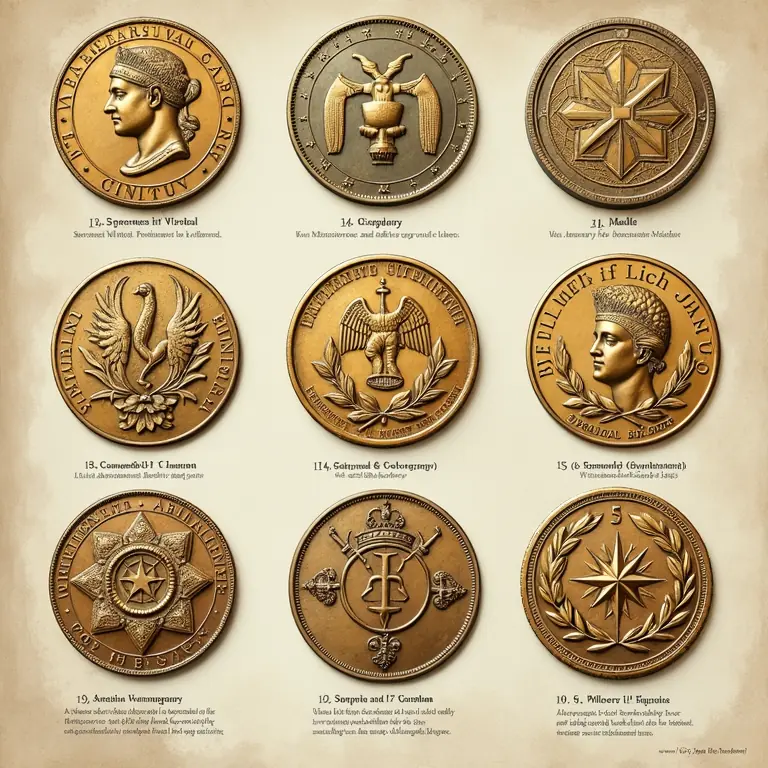Coins. We jingle them in our pockets, occasionally admire their shine, and generally take them for granted. But look closer. Every curve, every image, every inscription on a coin isn’t arbitrary. They are deliberate choices, steeped in history, symbolism, and often, a hefty dose of political messaging. From ancient Greece to modern circulating currency, coin design is a fascinating reflection of the societies that create them – a miniature canvas of power, propaganda, and cultural identity. This article delves into the surprisingly logical roots of coin design, exploring the stories behind the symbols, the evolution of techniques, and the ways coins have been used to shape narratives and project statecraft.
Ancient Beginnings: More Than Just Metal
The earliest coins, appearing in Lydia (modern-day Turkey) around the 7th century BCE, weren’t born out of a desire for beautiful artistry. They arose from the practical need to standardize trade. Before coins, bartering was the norm, and while functional, it lacked the convenience of a universally accepted medium of exchange. These early Lydian coins were made of electrum, a naturally occurring alloy of gold and silver, and stamped with the mark of the issuing authority – typically a ruler or city-state. This ‘stamp’ served as a guarantee of weight and purity, essentially a form of early certification.
However, even in these rudimentary beginnings, symbolism started creeping in. The earliest images weren’t just about authentication; they were about asserting authority. Lions, bulls, and other powerful animals were common motifs, representing the strength and dominion of the issuer. These weren’t just pretty pictures; they were visual statements of power. The Greeks, who quickly adopted and refined the concept of coinage, elevated this further.
Greek coins are renowned for their artistic quality and intricate designs. City-states like Athens, Corinth, and Syracuse used coins not only to facilitate trade but also to celebrate their patron deities, commemorate victories, and showcase their cultural identity. The owl of Athena, for example, became synonymous with Athens, appearing on its silver tetradrachms. The turtle of Aegae, a small island, adorned its coins, representing its local fauna and identity. Each coin was a miniature ambassador for its city-state, spreading its image and prestige throughout the Mediterranean world.
Roman Coinage: Propaganda and Imperial Power
The Romans were masters of propaganda, and their coinage reflected this. While initially borrowing heavily from Greek designs, Roman coins quickly evolved to become powerful tools of imperial messaging. Julius Caesar was the first Roman ruler to prominently feature his own portrait on coins – a revolutionary act that signaled a shift towards personalized rule and the cult of personality. This was a direct challenge to the Roman Republic’s traditions.
Subsequent emperors continued this trend, using coins to project an image of strength, virtue, and divine favor. Portraits weren’t simply realistic depictions; they were carefully crafted to emphasize desirable qualities – a strong jawline for decisiveness, a laurel wreath for victory, a serene expression for wisdom. The reverse sides of Roman coins often depicted scenes of military triumphs, religious rituals, and personifications of virtues like Pax (Peace) and Concordia (Harmony).
Roman coins weren’t just about glorifying the emperor. They also served to communicate important political messages. The introduction of new coin denominations, or changes to existing designs, could signal economic reforms or shifts in imperial policy. The quality of the metal used in coinage also reflected the empire’s economic health. A decline in silver content, for example, often indicated financial difficulties. The sheer reach of the Roman Empire meant that these messages were disseminated across a vast territory, influencing public opinion and reinforcing imperial authority.

Medieval and Renaissance Coins: Religious Symbolism and Dynastic Claims
With the fall of the Roman Empire, coin design in Europe fragmented. Medieval coins were often crude and lacking in artistic refinement, reflecting the political instability and economic disruption of the period. However, religious symbolism became increasingly prominent. Crosses, images of saints, and biblical scenes were common motifs, reflecting the dominant role of the Church in medieval life.
The Renaissance witnessed a revival of classical art and learning, and this was reflected in coin design. Italian city-states like Florence, Venice, and Milan produced coins of exceptional beauty and artistry, often featuring portraits of rulers, allegorical figures, and scenes from classical mythology. The revival of portraiture was particularly important, as it allowed rulers to project an image of power and legitimacy. The intricate detailing and humanist influences on these coins marked a significant departure from the more austere designs of the medieval period.
The Rise of National Minting: Standardisation and Sovereignty
As nation-states emerged in the early modern period, so too did centralized minting systems. This was a crucial development, as it allowed governments to exert greater control over the production and circulation of currency. Standardized coin designs became a symbol of national sovereignty, reinforcing a sense of collective identity.
The French *livre* and the Spanish *real*, for example, became widely accepted currencies in Europe, and their designs were carefully controlled by the respective governments. The image of the reigning monarch was prominently featured, reinforcing their authority and projecting an image of national pride. The development of sophisticated minting techniques, such as the use of screw presses, allowed for the production of coins with greater precision and detail.
Modern Coinage: Security, Symbolism, and the Art of Commemoration
Modern coinage, while incorporating advanced security features to combat counterfeiting, continues to reflect the traditions of the past. The portraits of heads of state remain a common motif, but contemporary coin designs often incorporate a wider range of symbols and themes.
Commemorative coins, in particular, have become increasingly popular. These coins are issued to celebrate significant events, honor historical figures, or raise awareness about important causes. The designs of commemorative coins often incorporate intricate artwork and symbolic imagery, making them highly collectible items. The United States, Canada, and Australia, among other countries, regularly issue commemorative coins that showcase their history, culture, and national identity.

Security features are paramount in modern coin design. Micro-engraving, latent images, and the use of specialized alloys are employed to deter counterfeiting. The constant battle between coin designers and counterfeiters has led to a continuous evolution of security technologies.
The Logic of Design: A Deeper Look
Beyond the historical and political context, the very *design* of coins often reflects logical considerations. The size, weight, and shape of a coin are determined by its intended value and the metal used in its production. The raised rims, for example, aren’t merely decorative; they protect the coin’s design from wear and tear and make it more difficult to counterfeit.
The placement of inscriptions and images is also carefully considered. Legends (the text on coins) are typically arranged around the perimeter, leaving the central field for the primary design. The orientation of the design is also important, as it can affect the coin’s visual impact. The choice of font is surprisingly important as well, impacting readability and conveying a certain aesthetic – something explored in the history of typography.
Even the *feel* of a coin is deliberately engineered. The milling (the ridges around the edge) isn’t just about security; it also provides a tactile element that helps people identify genuine coins. The overall design aims to create a coin that is both aesthetically pleasing and functionally efficient.
The Future of Coin Design
With the rise of digital currencies, the future of physical coinage is uncertain. However, coins are likely to remain relevant for the foreseeable future, particularly as collectibles and commemorative items.
We may see further experimentation with materials and designs, incorporating new technologies such as color-changing inks and holographic images. The use of 3D printing could also revolutionize coin production, allowing for the creation of highly detailed and personalized designs.
Despite the challenges posed by digital alternatives, the enduring appeal of physical coinage lies in its tangible connection to history, culture, and the art of craftsmanship. The stories embedded in these small metal discs continue to fascinate and inspire, reminding us that even the most commonplace objects can hold a wealth of meaning.
Further Exploration
Interested in other fascinating areas of everyday design? You might enjoy learning about:
- The History of Buttons – a seemingly simple fastener with a complex past.
- The Psychology of Playground Games – How games shape social skills and competition.
- The Physics of Bubbles – A delicate balance of science and wonder.
- The History of Chopsticks – A cultural icon with a surprisingly complex engineering history.


 The Curious Acoustics of Historical Echo Chambers: Resonance, Ritual, and Revelation
The Curious Acoustics of Historical Echo Chambers: Resonance, Ritual, and Revelation  The Curious Cartography of Scent: Mapping Perfume Ingredients Through History
The Curious Cartography of Scent: Mapping Perfume Ingredients Through History  The Curious Lexicon of Lost Trades
The Curious Lexicon of Lost Trades  The Surprisingly Consistent Science of Historical Ice Harvesting – A Frozen History of Commerce & Preservation
The Surprisingly Consistent Science of Historical Ice Harvesting – A Frozen History of Commerce & Preservation  The Unexpectedly Consistent Science of Historical Buttonhooks – Fashion, Function & Forgotten Tools
The Unexpectedly Consistent Science of Historical Buttonhooks – Fashion, Function & Forgotten Tools  The Surprisingly Consistent Science of Historical Toy Soldiers – Miniature Warfare, Materials & Collective Play
The Surprisingly Consistent Science of Historical Toy Soldiers – Miniature Warfare, Materials & Collective Play